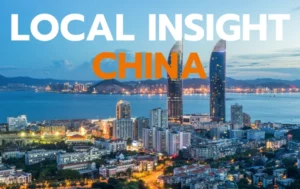In global business, windows of opportunity are measured in years, not decades. For SMEs and mid-market companies, expanding into China in 2025 is not just a strategic option—it is a race against time.
China is entering a rare alignment of macroeconomic momentum, consumer market expansion, digital transformation, and regulatory openness. It remains the world’s second-largest economy, accounting for a significant share of global growth, while a digitally connected middle class fuels record levels of consumption and innovation.
Yet this opportunity will not stay static. Domestic competition in the Chinese market is rising. Regulatory incentives designed to attract foreign entrants are time-bound. Market saturation in major cities is accelerating. Waiting is not a neutral act—it is a strategic disadvantage in the making.
This guide explains why expanding into China in 2025 offers SMEs and mid-market enterprises a narrow but highly valuable window to secure brand loyalty, operational advantages, and scalable growth. It focuses not only on market potential but on the critical actions companies must take now to convert opportunity into sustainable leadership in one of the world’s most dynamic economies.
1. China’s Market Power: Scale, Growth, and Urbanization
In global expansion, scale alone is never the full story. What matters is how accessible, dynamic, and strategically segmentable that scale is—and China in 2025 offers a combination unmatched anywhere else.
With a GDP exceeding $17 trillion and contributing a substantial share of global growth, China represents a gravitational center for international business. But the real transformation lies below the macroeconomic headlines: over two-thirds of China’s population now lives in urban areas, and more than 24 cities have populations exceeding five million. Each city is an economic organism of its own—with distinct consumer behaviors, industrial strengths, and regulatory frameworks.
The expansion of China’s middle class reinforces this fragmentation. Rising disposable incomes and shifting consumer expectations are creating diverse demand patterns, not just in Tier 1 cities, but increasingly in Tier 2 and Tier 3 urban centers where growth is faster and competition often lighter. Treating China as a single market is no longer a viable strategy. Precision is now the decisive factor between gaining early traction and being drowned in misaligned execution.
ALTIOS Insight:
SMEs and mid-market companies must approach China through a city-centric strategy, not a national one. Prioritize 2-3 target cities based on detailed segmentation: local industry ecosystems, consumer profiles, logistics infrastructure, and regulatory support. Launching with a sharply localized model increases operational effectiveness, reduces brand dilution, and sets a foundation for sustainable national expansion over time.
2. The Evolving Chinese Consumer: Digital, Quality-Seeking, Global-Minded
China’s consumer market is not merely changing—it is redefining the pace, scale, and nature of global consumption. For SMEs and mid-sized enterprises entering China in 2025, adapting to this evolution is not optional; it is the minimum condition for success.
Over 1.1 billion Chinese are now connected online, and digital commerce is not an alternative channel—it is the dominant one. Platforms such as Alibaba, JD.com, Pinduoduo, and the rise of live-stream commerce ecosystems have collapsed traditional barriers between marketing, sales, and logistics. More than 974 million consumers actively shop online, using mobile payments as a daily norm rather than a novelty.
Beyond digitalization, a deeper shift is underway. Chinese consumers—particularly Millennials and Gen Z—are redefining value: seeking quality, personalization, brand authenticity, and lifestyle alignment over simple price considerations. In sectors such as boutique skincare, smart home technologies, premium foods, and functional wellness products, demand is accelerating even as consumers become more discerning.
Critically, this appetite for quality is no longer confined to the major cities. With rural internet penetration above 76% and rising logistics efficiency, lower-tier cities now represent the next major consumer growth frontier—often with less brand saturation and lower competition.
Cross-border e-commerce provides mid-market companies with an immediate, strategic entry point. It offers the ability to test product-market fit, generate brand visibility, and build early customer loyalty before committing to full-scale local operations—a decisive advantage in a fast-moving, trend-driven market.
ALTIOS Insight:
SMEs and mid-market companies can treat cross-border e-commerce as the primary bridge into China’s consumer economy. Launching early through digital platforms allows companies to validate demand, fine-tune offerings to local preferences, and secure early-mover brand equity—all while minimizing capital risk. In China’s hyper-digital, trend-driven market, hesitation is a competitive disadvantage measured in weeks, not years.
3. Technology and Innovation: A Competitive Advantage for Early Entrants
China is not only a global manufacturing powerhouse—it has become one of the world’s most dynamic centers for technological innovation and commercial application. For mid-market companies, China is no longer just a market to enter; it is a platform to innovate, scale, and future-proof their global competitiveness.
By 2024, China was responsible for nearly a quarter of global research and development spending, with aggressive investments across artificial intelligence, biotechnology, green technologies, fintech, and advanced manufacturing. But it is the speed of adoption that truly sets China apart. Innovations move from lab to market faster here than in most other economies, driven by a digitally native consumer base and fiercely competitive domestic industries.
China’s technological infrastructure supports this acceleration. The country has built the world’s largest 5G network, enabling seamless mobile commerce, real-time data analytics, AI-powered services, and intelligent manufacturing platforms across every major city and industrial cluster. In hubs like Shenzhen, Beijing, and Shanghai, startups, manufacturers, and service providers form interconnected ecosystems that collapse innovation cycles from years to months.
For SMEs and mid-market enterprises, early engagement with China’s innovation ecosystem provides not just local market advantage but strategic global leverage. Companies that integrate into China’s tech platforms, talent networks, and collaborative development environments early gain access to capabilities—speed, scale, digital sophistication—that can be difficult to replicate elsewhere.
ALTIOS Insight:
SMEs and mid-market enterprises must treat China not merely as a customer market, but as a strategic innovation partner. Early movers should proactively seek partnerships with local technology firms, leverage startup ecosystems for rapid development, and integrate into digital platforms to scale quickly. In China’s fast-evolving innovation environment, embedding early is not just an advantage—it is a defense against future irrelevance.
4. An Open Window: Policy Reforms, Incentives, and Easier Market Entry
Market access in China is no longer reserved for multinational corporations with decades of presence. Recent policy reforms are reshaping the playing field—and for SMEs and mid-market companies willing to act quickly, the terms of entry have never been more favorable.
The implementation of China’s Foreign Investment Law has codified equal treatment for foreign businesses, offering stronger protections around market access, licensing, and intellectual property. Simultaneously, the national “Negative List” of restricted industries has been cut to historic lows, opening opportunities across manufacturing, services, agriculture, and technology sectors.
At a regional level, Free Trade Zones (FTZs) are offering targeted incentives: reduced corporate income tax rates, streamlined customs procedures, fast-tracked licensing, and access to R&D grants or export rebates. Local governments—from Guangdong to Hubei—are actively competing to attract foreign investment, providing flexibility and support that would have been unthinkable a decade ago.
Yet the strategic window to capture these advantages is finite. As sectors mature and domestic players strengthen, China’s incentive programs and regulatory fast-tracks will inevitably favor early entrants. Companies that establish a local footprint now will not only secure first-mover benefits but also lock in access to incentive structures that latecomers will find much harder to negotiate in the Chinese market.
ALTIOS Insight:
SMEs and mid-market enterprises must treat incentive optimization and regulatory positioning as a first-stage priority—not a post-entry adjustment. Conduct early, detailed mapping of Free Trade Zones, sector-specific tax advantages, and regional subsidy programs. Structuring market entry to maximize incentive capture today will provide cost, speed, and operational advantages that competitors entering in two or three years may never recover.
5. Supply Chain and Manufacturing: Beyond Cost, Toward Strategic Integration
China’s role in global manufacturing is not static—it is evolving from a cost-driven production base to an integrated innovation and distribution platform. For businesses of all sizes expanding in 2025, the strategic opportunity is no longer just lower costs; it is access to a full-spectrum supply chain ecosystem capable of compressing innovation, production, and market delivery cycles at scale.
China continues to dominate global manufacturing output, but its real advantage lies in its industrial clusters—concentrated networks of suppliers, manufacturers, R&D centers, and logistics hubs that allow businesses to move from product design to scaled manufacturing faster than anywhere else. In regions like the Greater Bay Area, Yangtze River Delta, and Bohai Economic Rim, SMEs and mid-market companies can tap into supply networks that compress product launch timelines from years to months.
Infrastructure investment compounds this advantage. China is home to seven of the world’s ten largest container ports, an unrivaled high-speed rail network, and deeply integrated logistics systems that support both domestic distribution and global exports. No other market offers this combination of scale, speed, and operational flexibility—at this level of maturity—today.
Moreover, China’s role in regional trade frameworks, particularly the Regional Comprehensive Economic Partnership (RCEP), amplifies its utility as a gateway to broader Asia-Pacific markets. Companies that embed manufacturing or assembly operations in China position themselves to export under preferential trade terms to more than a dozen key markets—a competitive advantage that compounds over time.
ALTIOS Insight:
SMEs and mid-market businesses must move beyond simple sourcing strategies and embed themselves within China’s supply chain ecosystems early. Mapping key manufacturing hubs, building supplier and logistics partnerships, and structuring operations to maximize RCEP trade advantages will not only cut costs—it will compress innovation cycles and accelerate global scaling. In supply chain strategy, first movers secure speed, resilience, and reach that late entrants struggle to match.
6. China’s Second-Tier and Third-Tier Cities: The Next Untapped Battleground
While the global spotlight remains fixed on Shanghai, Beijing, and Shenzhen, the future of market success in China is rapidly shifting elsewhere—into the country’s second- and third-tier cities. For SMEs and mid-market companies prepared to move early, these emerging urban centers offer a strategic opportunity to build market leadership before competition intensifies.
Cities like Chengdu, Hangzhou, Nanjing, Wuhan, and Changsha are no longer peripheral markets. They are fast-growing economic engines, fueled by rising middle-class populations, major infrastructure investments, and increasingly sophisticated consumer demand. Critically, these cities remain underserved by foreign brands, creating the rare conditions where early entrants can dominate local mindshare and secure premium positioning with relatively lower initial investment.
Operational advantages are equally compelling. Talent costs, real estate, logistics, and marketing expenditures are often 20% to 50% lower than in Tier 1 cities—without sacrificing access to critical digital infrastructure like 5G, mobile payments, or e-commerce logistics. Local governments, eager to stimulate international engagement, are offering targeted incentives that can further tilt the playing field in favor of early foreign investors.
However, these windows will close rapidly. Domestic competitors are moving aggressively to capture loyalty in these markets, and foreign companies that delay entry risk facing entrenched rivals, higher acquisition costs, and diminished brand differentiation.
ALTIOS Insight:
SMEs and mid-market enterprises must develop a second-city strategy as a core pillar of their China market entry. Prioritize cities based on industry clustering, consumption growth rates, and regional policy support. Move quickly to establish local partnerships, secure distributor relationships, and build brand presence before the competitive intensity rises. In China’s evolving urban landscape, first-mover advantage outside Tier 1 cities will define the next decade of success for businesses of all sizes.
7. Capital Efficiency: Leveraging Size Advantages in the China Expansion Equation
Both SMEs and mid-market companies possess distinct advantages in China’s dynamic market that can be strategically leveraged against the market’s evolving dynamics.
SMEs benefit from extreme agility and focused expertise, allowing them to target specialized niches with precision. Their lean decision-making structures enable rapid pivots as market conditions change—a critical advantage in China’s fast-evolving consumer landscape. Meanwhile, mid-market enterprises combine operational flexibility with sufficient capital reserves, allowing them to pursue more substantial opportunities while avoiding the bureaucratic constraints faced by multinationals.
For smaller companies looking to expand, China offers the opportunity to leverage specialized expertise and product differentiation across a massive market. For mid-sized businesses, their unique advantage lies in the ability to capitalize on both enterprise-level opportunities and consumer-facing markets simultaneously—creating diversified revenue strategies that mitigate expansion risks.
This flexibility is particularly valuable in China’s current environment. As the country’s economic policy increasingly emphasizes both domestic consumption and industrial upgrading, companies of all sizes can position themselves strategically—with SMEs often excelling in agile consumer innovation while mid-market companies can bridge both B2B and B2C channels effectively.
ALTIOS Insight:
Companies should match their expansion strategy to their organizational strengths. SMEs should leverage nimbleness by testing targeted offerings in specific city markets, while mid-market enterprises can deploy a broader, phased approach across multiple channels. Both should begin with focused initiatives requiring appropriate investment levels—cross-border e-commerce, strategic partnerships, or targeted distribution agreements. Treat China as a portfolio of opportunities rather than a single market bet, using early performance data to guide subsequent capital deployment. This staged approach maximizes optionality while minimizing sunk costs, a critical advantage for companies looking to expand their business in the Chinese market.
8. First Movers vs. Latecomers: Why Early Action Pays
In China’s fast-evolving market landscape, timing is not a tactical detail—it is a core source of competitive advantage. For SMEs and mid-market companies, the difference between entering now and waiting even 18 to 24 months can mean the difference between establishing brand leadership and fighting an uphill battle for visibility, distribution, and customer loyalty.
First movers secure more than early revenue. They embed themselves into critical networks: forming local government relationships, building distributor partnerships, attracting top talent, and locking in favorable regulatory or incentive terms that later entrants often struggle to replicate. Early entrants also enjoy disproportionate brand loyalty, especially in sectors where trust, experience, and premium positioning influence consumer decisions.
Meanwhile, the costs of waiting are tangible and compounding. Customer acquisition costs rise sharply as local competitors establish entrenched positions. Incentive programs narrow or expire as government targets for foreign investment are met. Land, labor, and logistics costs trend upward in high-growth cities, eroding margin structures for latecomers. Most damaging of all, brand newcomers must invest significantly more in marketing, partnerships, and localization to dislodge early market leaders.
ALTIOS Insight:
SMEs and mid-market enterprises should approach China with a first-mover mindset—treating early market entry as a strategic investment that compounds operational, financial, and brand advantages over time. Parallel-track entity setup, regulatory structuring, digital market entry, and partnership building from day one. In China’s hyper-competitive environment, speed is not a tactic—it is a strategic necessity.
Conclusion: China’s Strategic Window Is Open—but Only for Those Who Move Decisively
The case for why SMEs and mid-market companies should expand into China in 2025 is not theoretical. It is grounded in structural shifts that are already reshaping global commerce: a massive and dynamic consumer market, a world-leading digital ecosystem, advanced manufacturing and supply chains, and a regulatory environment actively welcoming foreign businesses—for now.
Yet timing is critical. The combination of policy openness, digital acceleration, and underserved regional markets will not remain static. Early entrants will secure not only operational advantages but also consumer loyalty, brand equity, and access to incentives that latecomers may never recover.
Successful expansion into China requires more than ambition. It demands strategic clarity, precise market selection, regulatory expertise, operational speed, and cultural fluency. Companies of all sizes that act now—with the right preparation and guidance—will position themselves not just to grow, but to lead in one of the most vital markets of the next decade.
China’s window of opportunity is open—but it is already beginning to narrow. Mid-market companies that align speed with strategy, and partner with the right experts, can turn this unique moment into a foundation for long-term global leadership.
FAQ: Expanding into China in 2025
What sectors offer the best opportunities for SMEs and mid-market companies in China?
Sectors driven by rising middle-class consumption, digital transformation, and sustainability are the most promising. These include health and wellness products, premium food and beverages, boutique personal care, smart home technologies, green energy solutions, advanced manufacturing, specialized B2B services, and educational services. Regional differences matter: businesses should align sector focus with local city strengths and consumer profiles.
How long does it typically take to set up a business entity in China?
Setting up and activating a wholly foreign-owned enterprise (WFOE) typically takes between 3 to 6 months, depending on the industry, region, and regulatory complexity. Using Free Trade Zones or specific economic development areas can streamline the process and reduce bureaucratic hurdles. Companies should plan early and parallel-track entity setup with market entry preparations.
Is it necessary to have a local partner to succeed in China?
No, but it can be highly beneficial depending on your sector. While WFOE structures are increasingly common and legally protected, certain industries and geographic markets still favor companies that can demonstrate strong local relationships. SMEs and mid-market enterprises should carefully assess whether partnerships will enhance market access, credibility, and speed—especially in lower-tier cities.
What advantages do different-sized companies have in expanding their business to China?
Each company size offers distinct advantages in China:
SMEs excel with nimbleness, focused expertise, and ability to target specialized niches with precision. Their lean structures enable rapid pivots as market conditions change—a significant advantage in fast-evolving consumer segments.
Mid-market companies combine the best of both worlds: sufficient scale and resources to make meaningful investments while maintaining the agility to pivot quickly in response to market feedback. Unlike smaller enterprises, they can absorb the initial costs of proper market entry; unlike multinationals, they can make decisions rapidly without extensive global approval processes.
This operational flexibility at both scales is particularly valuable in China’s fast-changing business environment, with each company size able to leverage its inherent strengths
Are incentives and tax breaks available specifically for foreign mid-market companies?
Yes. Free Trade Zones and certain high-tech industrial parks offer reduced corporate income taxes, grants, subsidized land use, expedited licensing, and R&D support for qualifying foreign businesses. The availability and terms vary by region and sector, making early research and local consultation critical.
What are the major risks companies should prepare for when entering China?
Key risks include misunderstanding local consumer preferences, underestimating regulatory complexities, weak local partnerships, insufficient IP protection, and capital misallocation. To mitigate these, SMEs and mid-sized enterprises should invest in appropriate levels of market research, localize offerings carefully, engage qualified legal and business advisors, and adopt a phased, learning-driven entry strategy with clear performance metrics.








